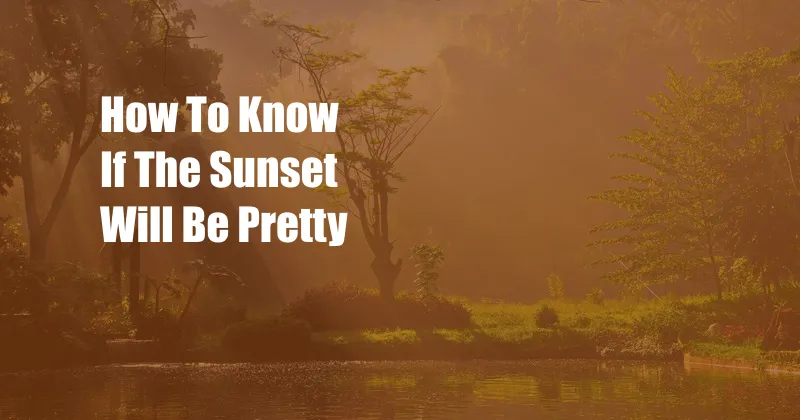
How to Tell if the Sunset Will Be Spectacular
Watching a sunset is one of summertime’s simple pleasures, but sometimes nature’s grand finale is more of a whimper than a showstopper. So, how do you know if the sunset will be a panoramic panorama you’ll be posting to Instagram or just another ho-hum way to end the day?
Sunset enthusiasts have developed a set of rules to predict the likelihood of a great show. So if you’re planning a beach picnic or a romantic stroll, check the weather forecast for the evening and see if the conditions are right.
The Clouds: The Key to a Gorgeous Sky
The key to a great sunset is clouds – but not just any clouds. You want clouds with thickness and height. Thin, wispy clouds won’t give you much of a show. Dramatic, puffy clouds are the best. The reason? Clouds scatter and diffract sunlight. The thicker the clouds, the more scattering and diffraction, and the more colorful the sunset.
Clouds can create a stunning scene on their own, but if they’re too thick, they can block the sun entirely. So, perfect sunset conditions call for clouds that are thick enough to scatter sunlight but thin enough to let the sun peek through.
The Winds: How They Affect the Sunset
Wind plays a role in how the clouds are arranged in the sky. If the wind is blowing in one direction, the clouds will be stretched out in that direction. If the wind is blowing in multiple directions, the clouds will be more scattered. Generally, winds that push clouds across the sky well before sunset will help ensure a colorful sky when the sun finally dips below the horizon.
So what kind of wind do you want? A gentle breeze is best. It will move the clouds around enough to create interesting shapes and textures, but it won’t blow them away completely.
The Humidity: Moisture in the Atmosphere
Humidity is a measure of the amount of water vapor in the air. High humidity can create a haze that can obscure the sunset. Generally, lower humidity levels are better for sunsets, but some humidity can highlight dust and particles in the atmosphere, which, in turn, can scatter more sunlight.
The ideal humidity level for a sunset is around 50%. This is low enough to avoid any haze, but high enough to maximize the colors.
The Air Quality: Pollution’s Impact on the Sunset
Air quality is another factor that can affect the sunset. Pollution can create a haze that can obscure the view. The best air quality for sunsets is when the air is clear and free of pollution.
You can check the air quality forecast for your area online. If the air quality is good, you’re more likely to have a great sunset.
Expert Tips for Predicting a Colorful Sunset
Here are a few general rules to help you predict the likelihood of a great sunset:
- Look for clouds. The best sunsets happen when there are clouds in the sky.
- Check the wind direction. A gentle breeze is best.
- Monitor the humidity. The ideal humidity level for a sunset is around 50%.
- Check the air quality. The best sunsets happen when the air is clear and free of pollution.
Of course, these are just general rules. There’s no guarantee that you’ll have a great sunset every time the conditions are right. But if you keep these factors in mind, you’ll be more likely to catch a breathtaking show.
FAQ: Frequently Asked Questions About Sunsets
Here are some of the most frequently asked questions about sunsets:
Q: Why are sunsets red?
A: The sun’s light is made up of all the colors of the rainbow. However, blue light has a shorter wavelength than red light, so it is scattered more by the Earth’s atmosphere. As the sun sets, the blue light is scattered away, leaving the longer wavelength colors, such as red, orange, and yellow.
Q: Why do some sunsets look green?
A: Green sunsets are caused by a combination of factors, including the presence of water vapor and dust in the atmosphere. Water vapor can absorb red light, leaving the green light to be scattered. Dust can also scatter blue light, which can add to the green color of a sunset.
Q: Why do sunsets look different in different parts of the world?
A: The colors of a sunset are affected by the composition and density of the atmosphere, which can vary depending on the location. For example, sunsets tend to be more orange and red in areas with high levels of pollution, while they tend to be more blue and green in areas with low levels of pollution.
Q: What is the best time to see a sunset?
A: The best time to see a sunset is about 30 minutes after the sun has set below the horizon. This is when the colors are most vibrant.
Conclusion
Sunsets are a beautiful sight to behold, and they can be even more spectacular if you know what to look for. By understanding the factors that affect sunsets, you can improve your chances of catching a breathtaking show.
So, the next time you’re planning a sunset outing, take a moment to check the weather forecast and see if the conditions are right. If the clouds are thick, the wind is gentle, the humidity is moderate, and the air quality is good, you’re in for a treat.
Now, I’d love to hear from you. Are you interested in learning more about sunsets? Do you have any tips for predicting a great sunset? Share your thoughts in the comments below.